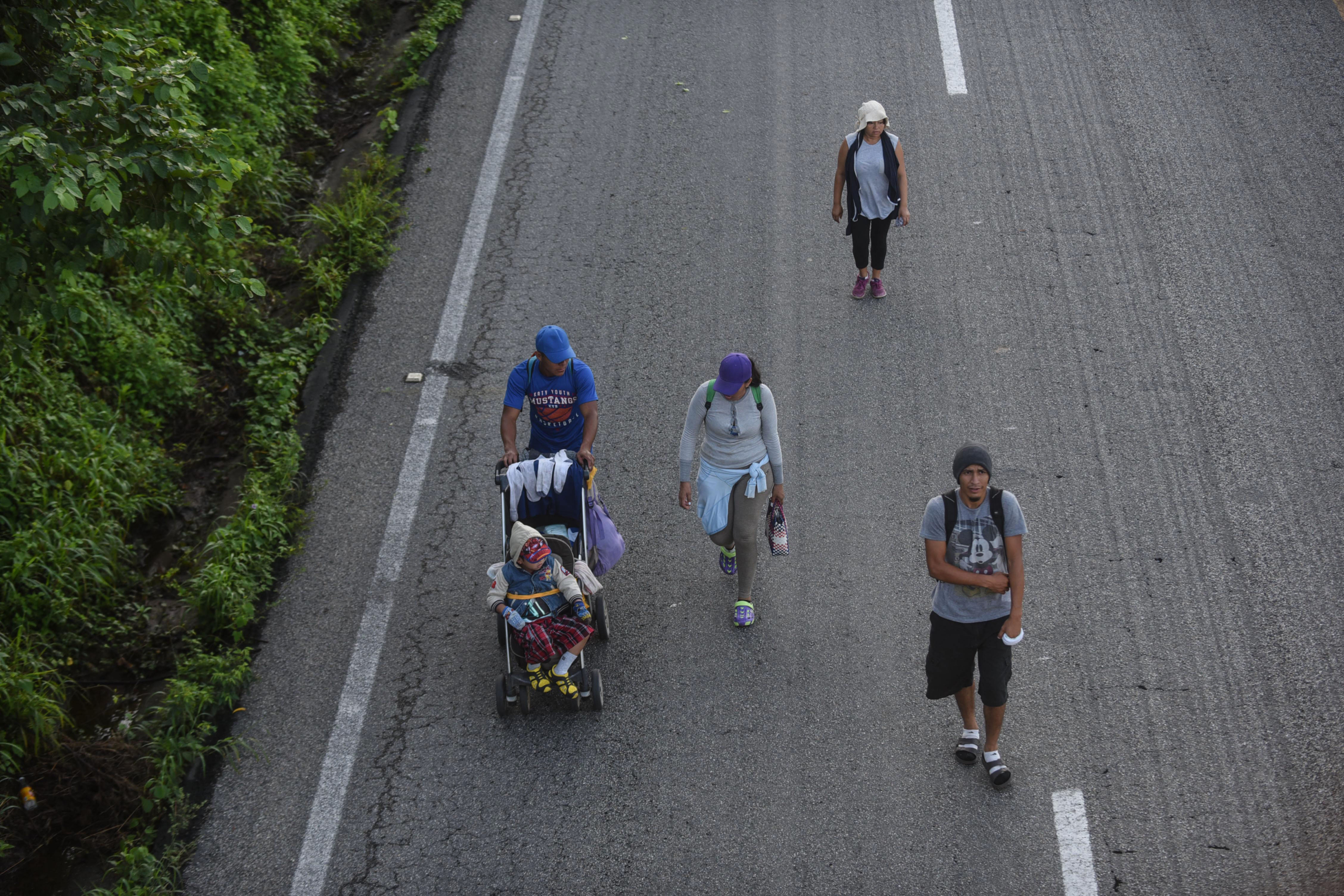The story of the Central American migrant caravan dominated cable news for weeks; then it turned up in the social media accounts of Cesar Sayoc, who has been accused of mailing pipe bombs to more than a dozen prominent Democrats, and Robert Bowers, who was charged with murdering 11 people during a bris at a synagogue in Pittsburgh over the weekend.
The debate over the caravan of mostly Honduran migrants on their way to the US-Mexico border has become the most important theme of the final stretch of the 2018 midterm elections. This collection of raging controversies seems guaranteed to stir voter anger.
One rumor about the caravan has quickly solidified, amplified by mainstream outlets’ headlines and fact checks: that George Soros is personally funding the caravan, that he is somehow behind the group Pueblos Sin Fronteras that organized it, and that its purpose is to change the outcome of the midterms to favor the radical left.
Where and when did these claims originate, and how did they creep into news headlines? In my research, published on Medium last week, I found the earliest social media posts that kicked off the Soros-funded-migrant caravan narrative.
The earliest claims of a direct link between “Soros” (funding) and “caravan” appear to have been posted to Twitter on March 30.
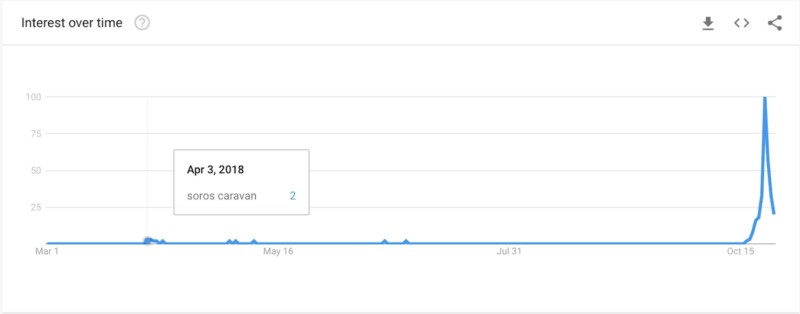
Photo: Google Trends
Of course, this was a different caravan. But it’s the origin of the larger theme and, more importantly, the associative keywords. The story of another supposedly Soros-funded caravan was amplified in April by TheBlaze and WorldNetDaily, along with the usual assortment of blogs, sketchy Keep America Great bots, red-hat-wearing humans, and indirectly by mainstream publications, fact checks, and left-wing sites who amplified the rumor by criticizing it.
Let’s begin at the beginning. (CJR has removed information that would identify specific active accounts in order to avoid contributing to the spread of misinformation.)
- The first tweet attributing the caravan to Soros appeared on Twitter at the end of March. (And no, there is no reference to that claim in the Breitbart story about this caravan, which is linked in the tweet.)

- A handful of caravan references appeared on Twitter during the last two days in March. One tweet linked to a conspiracy video on YouTube, which is still up. But the video doesn’t draw a direct connection between the Central American caravan and Soros. The tweet also links to a thread on the message board Voat from March 31, which contains comments that do attempt to establish the caravan-funding narrative.
- Another March 31 tweet from an astroturf account links to a BuzzFeed story, again, in which George Soros isn’t mentioned at all.

- Next, also on March 31, a reply pops up under a tweet by Fox Business host Lou Dobbs, tagging right-wing blogger and Fox News host Sara A. Carter. The reply strikes an innocent tone—just a friendly, interested citizen, wondering whether we should investigate this!
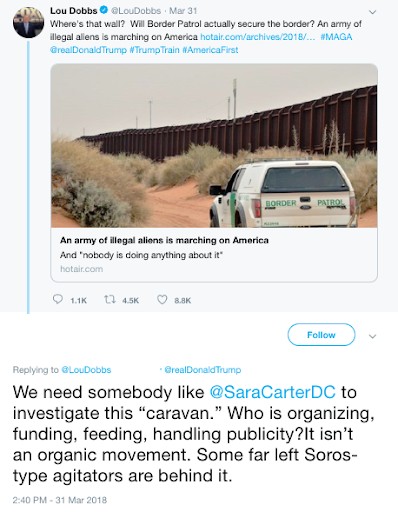
- By April 2, the conspiracists stop being coy; for the first time, a Twitter account links to content published outside of forums and social media. The article, an op-ed from a right-wing fringe site called The Goldwater, asserts a direct link between Soros and funding of the immigrant caravan.

The tweet linking to this piece can’t be found on Twitter or through its API, because the account has been suspended and removed. That tweet came from someone with the screen name “Courtney T,” tweeting from the handle @IWillRedPillU, and the handle links in to a whole new world of MAGA political propaganda. The name on the op-ed? Courtney Tubb.

Dobbs picks up the thread quickly. On Lou Dobbs Tonight on April 3, in a segment grilling Republican congresswoman Martha McSally about the slow movement on funding for Trump’s border wall, Dobbs asked:
How about people without borders [Pueblos sin Fronteras]? How about all of the NGOs, the nonprofits, many of them funded by George Soros and other left-wing groups who are trying to radicalize them and move them into—and by the way, how about President Obama’s eight-year administration that was incentivizing Central Americans to come here?
Since the end of that caravan in April—150 migrants sought asylum at the US border, and the Justice Department brought criminal charges against 11— the conspiracy theory seems to have preyed on the minds of conservatives. Almost immediately after the October 13 Reuters report on the migrant caravan currently approaching the US border, right-wing outlets like Fox News saw their Twitter mentions flooded with replies blaming Soros in a story relying on the Reuters reporting. Though Soros is mentioned nowhere in the Fox story, users replying to the outlet’s tweet linking to the story immediately blamed the Jewish billionaire. “Another Soros move,” wrote one user of many. “Brought to you by Soros-Clinton,” replied another.
The rumor mill snowballed from comments, replies, and shares to livestreams by prominent right-wing personalities. Television news channels and programs now regularly cover this story that originated in a Twitter reply from a pseudonymous account.
And, of course, succinct explanations of the conspiracy theory are crudely pasted all over important social media channels, such as active political Facebook groups:
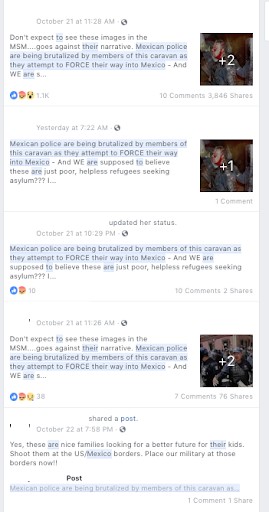
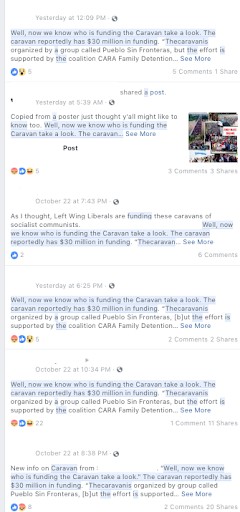
More recently, on October 23, Dobbs himself has doubled down:
#LDTPoll: Do you think the Radical Left is working with Central and South American socialists and leftists to organize and support the migrant caravan?
— Lou Dobbs (@LouDobbs) October 23, 2018
The following day, Cesar Altieri Sayoc was arrested by authorities in Florida as a suspect in the bombs mailed to Soros and others. He was linked to two Twitter accounts; the last tweet on the first account, @hardrock2016, was a meme about Soros. Including his second account with the handle @hardrockintlet, text in the tweets and contained within the images, Sayoc’s Twitter accounts contained 406 mentions of Soros:

Now, in October, only days before the midterm elections, the caravan continues. Its talking points—keywords—reinforced in social media posts, link shares, comments, online forums, and television programs.
It spreads through disinformation, as shown in the October 25 tweet below:
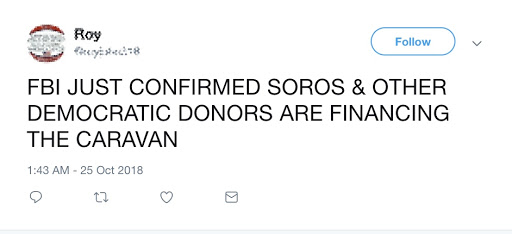
It is repeated in snark by media personalities and influencers:
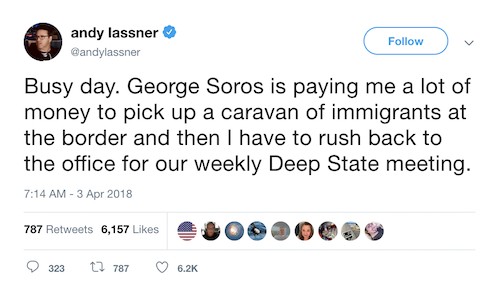
It is debunked by right-wing news outlets with quotes from the vice president.

The legitimization of the narrative happens by commanding a critical mass of attention; it is reinforced in click-seeking mainstream headlines and fact-checks through keyword repetition. It is platformless—rumores sin fronteras.



